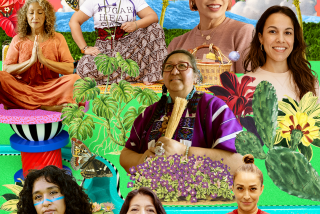Science Taking Lessons From Mayan Medicine Men, Shamans ‘Who Speak to Gods’
- Share via
SAN JUAN CHAMULA, Mexico — Scientists are studying the traditional Mayan medicine still practiced by thousands of Indians in Mexico’s southern highlands, some of whom speak to the gods from sacred hilltops.
There are yerberos , or experts in medicinal herbs; parteras , or midwives and pediatricians; pulsadores , who diagnose by reading the pulse, and hueseros , who set bones and act as the rough equivalent of chiropractors.
Most exalted are the curanderos , also called shamans or rezadores de los cerros : those who know how to speak to the gods.
Among them is Sebastian Gonzalez, who lives in Chamula, a town in the highlands of Chiapas state near the Guatemala frontier.
“My grandfather was a curandero and I’ve been a curandero since I was 8 years old, when I began to dream about people with big baskets of flowers,” said Gonzalez, 48.
Those dreams led a pulsador to declare that the boy was a curandero . At first Gonzalez worked with candles, a key element of religious ceremonies that mix ancient pantheism with the Roman Catholicism brought by Spanish conquerors.
“When I was about 14 or 15 years old, I began to ask my grandfather about plants,” Gonzalez said.
Brent Berlin, a linguistic anthropologist from UC Berkeley, leads a joint U.S.-Mexican project to compile an encyclopedia of contemporary Mayan medicine in several languages, including Tzotzil, which is spoken in Chamula.
“If you could look inside a Mayan Indian’s head, about 80% is going to have something to do with the world of plants,” he said. “They are very close to the earth. These people have been agriculturists for thousands of years.”
Herbal medicine is taken seriously in Mexico. People in all walks of life and every part of the country use the cures.
Government health agencies enlist the aid of practitioners and are studying the plants many of them use.
Gonzalez, president of the state Organization of Indigenous Doctors, said about 7,000 curanderos practice in Chiapas. He said he has learned how to use about 300 medicinal plants, each of which has special rules for preparation and use.
“There are plants that can’t be picked by men; there are plants that can’t be picked by women,” he explained. “There are plants that must be used dry and others that must be used fresh.”
He said the compass points are important when a shaman prays on a sacred hilltop.
A curandero known as Don Antonio said he made his reputation in 1926, at age 19 or 20, after a villager was hit by a truck and suffered a nosebleed that would not stop. Don Antonio said he stopped it after a week with tree bark and prayers.
A grant from the U.S. National Science Foundation in late 1986 allowed Berlin to start the ambitious project of cataloguing contemporary Mayan medicine and its array of herbs.
Researchers have collected 1,500 species of medicinal plants and identified 98% of them, Berlin said, and compiled the Mayan names of almost 200 illnesses.
Traditional medicine has a valid role, Berlin said, especially among people like the Indians of Chiapas. He described them as a “Fourth World population that does not have access to the resources, the assets of the rest of Mexican society.”
He pointed out that Mayan medicine does not involve expensive doctors and the herbs are easily obtainable, either free or inexpensive.
“This knowledge of the medicinal properties of the flora is widely shared by the community,” he said. “What’s not shared is how to talk to the gods.”
More to Read
Sign up for Essential California
The most important California stories and recommendations in your inbox every morning.
You may occasionally receive promotional content from the Los Angeles Times.












